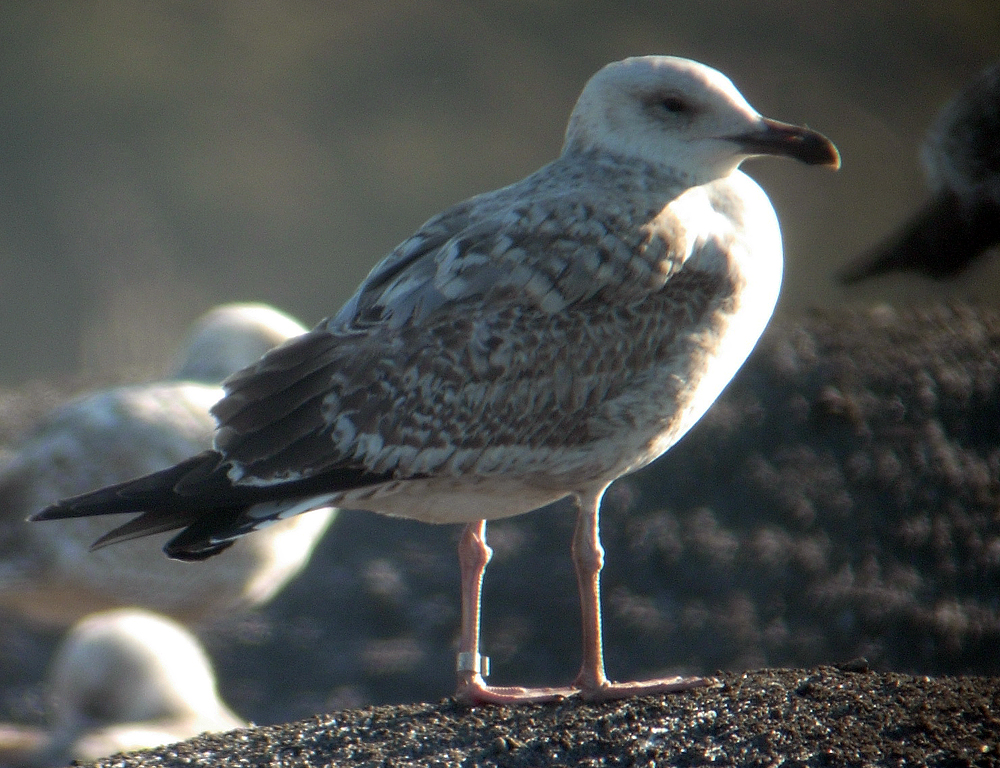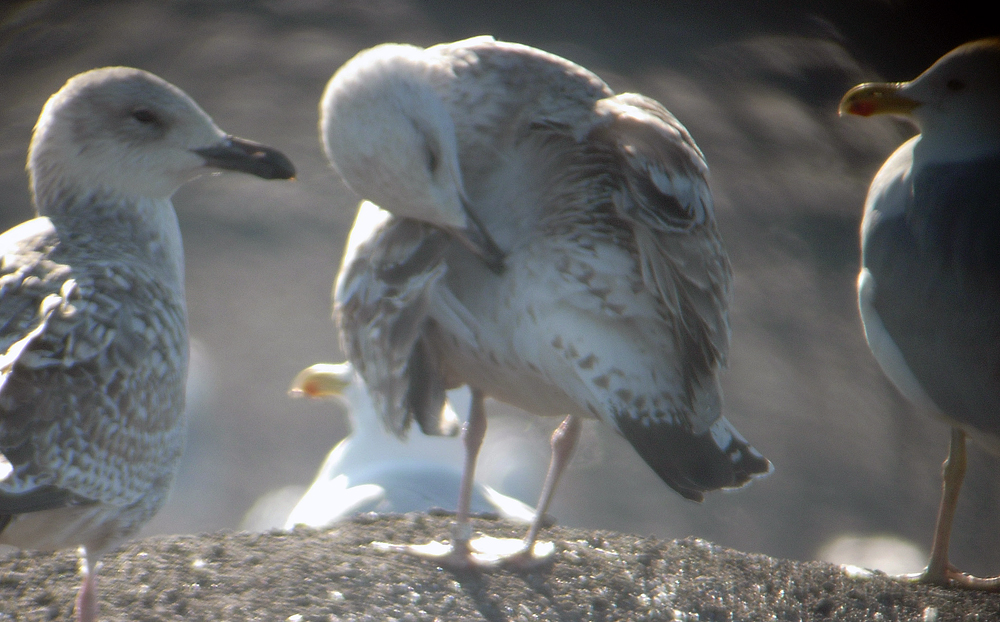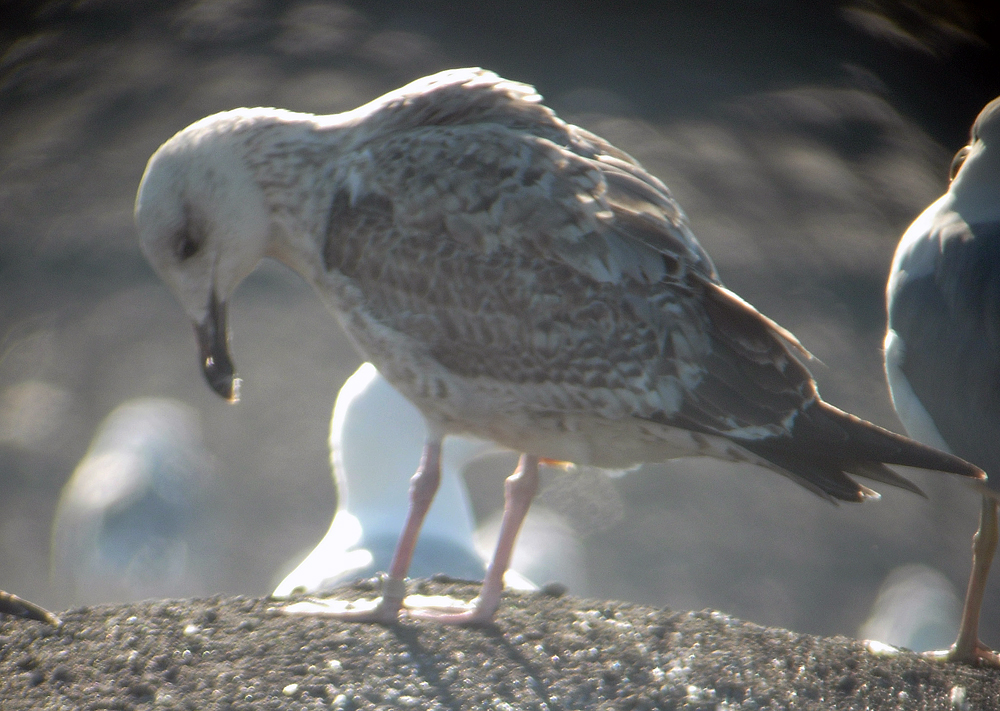 Larus cachinnans
Larus cachinnans
(last update:
Greg Neubauer
Marcin Przymencki
Albert de Jong
Mars Muusse
cachinnans plumages
Larus cachinnans hybrid? 2CY-3CY PLG DN-04520 March 2005 - March 2006, Deponie Pohlsche Heide - Minden, Germany (52°23'05N, 08°46'45E).
Picture: Armin Deutsch.
Ringed as pullus cachinnans on June 18 2004 at Włocławek Reservoir, central Poland (51°16'N, 21°52'E).
below: cachinnans hybrid? 2CY PLG DN-04520 March 10 2005, Deponie Pohlsche Heide - Minden, Germany (52°23'05N, 08°46'45E). Picture: Armin Deutsch.
At first glance a few cachinnans features are apparent, inlcluding greyish scapulars and replaced wing-coverts. However some characteristics odd:
- rather heavy bill
- angular head
- much streaking on head
- short thick legs
- strong piano key pattern on GC
- several rear lower scapulars still juvenile
- notched fringe on lower tertials.
Therefore we copy table 2 again to score this individual (below the pictures).




Below, table 2 is repeated to score this bird. The scores are in italic + bold.
Overall score is 27, which places this bird in the hybrid zone of the spectrum, beyond the score for pure cachinnans and below the score for pure argentatus (see figure 8). This supports the idea of a classic hybrid.
Table 2. Traits and scores used to characterise birds in first-winter plumage (October-March inclusive).
|
||
| Trait | Score | Description |
| Extent of scapular moult | 0 | no first-generation feathers remaining |
| 1 | a small number (<1/3) of first-generation feathers remaining | |
| 2 | a significant number (>1/3) of first-generation feathers remaining | |
| Greater-covert pattern | 0 | simple pattern with brown centres and sharp white edges, with no white vermiculation or notching |
| 1 | white edges with delicate notches or vermiculation; or dark brown centre with white tip to 1/3 of length (i.e. white restricted to tip or distal third) | |
| 2 | clear white notches / barring creating a delicate 'piano key' pattern along the whole edge / feather; but much of feather dark | |
| 3 | lots of white (more than 1/2 of coverts looking white) distributed along the whole feather, or a bold notching ('piano key' pattern) | |
| Bill shape | 0 | Very long and slim, no visible gonydeal angle (L:D ratio >2.8) |
| 1 | Slim, slight gonydeal angle (ratio 2.4-2.79) measured 2,59 Mars Muusse | |
| 2 | Intermediate (ratio 2.0-2.39) | |
| 3 | Short and deep, well marked gonys angle (ratio <2) | |
| Leg length | 0 | Long and slim looking |
| 1 | Moderately long | |
| 2 | Short or short and stocky | |
| Ventral bulge | 0 | present |
| 1 | absent | |
| Primary projection | 0 | very long (ratio >0.6) |
| 1 | moderately long (ratio 0.5-0.59) | |
| 2 | medium (ratio 0.4-0.49) | |
| 3 | short (ratio <0.4) | |
| Moult: greater coverts | 0 | all or almost all new (>75%) |
| 1 | 51-75% new | |
| 2 | 34-50% new | |
| 3 | 10-33% new | |
| 4 | one or two feathers moulted | |
| 5 | no moult | |
| Moult: median coverts | 0 | all or almost all new (>75%) |
| 1 | 51-75% new | |
| 2 | 34-50% new | |
| 3 | 10-33% new | |
| 4 | one or two feathers moulted | |
| 5 | no moult | |
| Moult: tertials | 0 | 3 or more new |
| 1 | 2 new | |
| 2 | 1 new | |
| 3 | all old | |
| Darkness of head and body | 0 | totally white |
| 1 | reduced grey wash or streaking (confined to flanks and/or single streaks around nape) | |
| 2 | light streaking/wash to head (incl. some dark around eye); isolated streaks/blotches on body. Overall, body looks more white than brown | |
| 3 | well streaked: dark mask around eye and/or streaking covering the whole head/face; body with extensive but moderately dense streaks/mottles | |
| 4 | strong and dense streaking/mottling on body and head making it appear almost wholly dark | |
| First-generation tertial pattern | 0 | diffuse white tip (like Common Gull Larus canus) |
| 1 | fine pale fringe around distal portion (like classic michahellis), possibly also with some vermiculations | |
| 2 | edges moderately notched | |
| 3 | edges strongly notched and/or some dark barring or pale patches across the feather on some or all tertials | |
| Second-generation scapular pattern | 0 | uniformly silvery-grey, darker patterning absent or very faint |
| 1 | silvery-grey background, pattern stronger than on 0, but lacks strong barring or central dark diamonds (only dark shafts and subtle anchors), with only a minority (one or two) of such feathers admixed | |
| 2 | strong, contrasting shaft-streaks, anchors and/or dark central diamonds, but these more patterned feathers are less than 1/2 of all; ground colour creamy or silvery-grey, possibly with some grey feathers mixed in | |
| 3 | strong pattern described in 2 on most (more than 1/2) of feathers, but possibly also one or two plain grey feathers or feathers with grey ground tone | |
| 4 | all feathers contrastingly patterned (with dark cross bars or diamonds), lacking plain grey feathers; feather centres buffy-brown | |
below: cachinnans hybrid? 3CY PLG DN-04520 March 09 2006, Deponie Pohlsche Heide - Minden, Germany (52°23'05N, 08°46'45E). Picture: Armin Deutsch.
Head shape not trypical for cachinnans.
